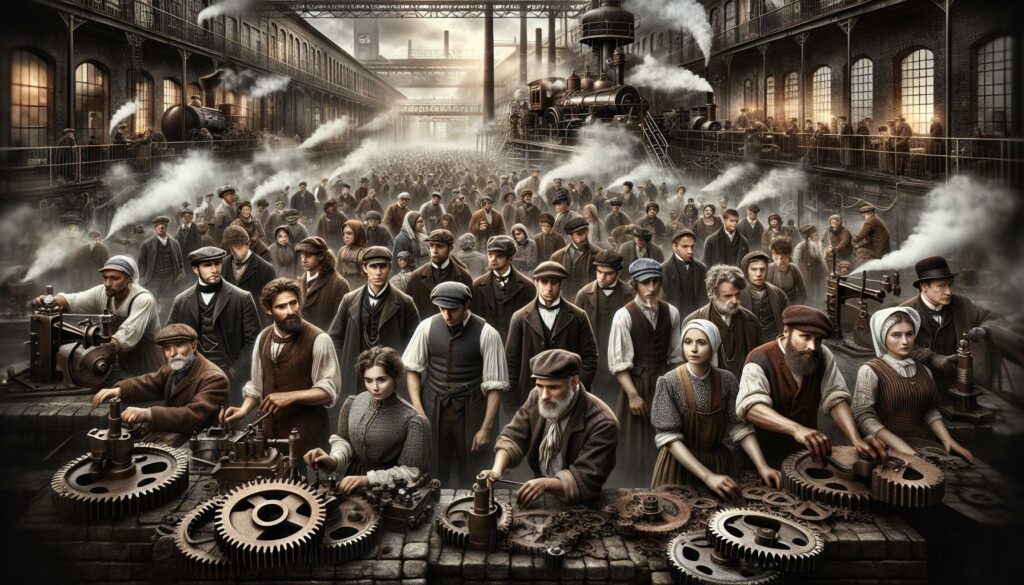I’ve always been fascinated by how the Industrial Revolution sparked incredible transformations in literature, particularly in science fiction. The smoke-filled skies, clanking machinery and rapid technological changes of the 19th century provided fertile ground for writers to imagine fantastic futures and alternative realities.
As I explore the science fiction inspired by industrial revolution, it’s remarkable to see how authors like H.G. Wells and Jules Verne drew direct inspiration from the revolutionary innovations of their time. Steam engines became time machines, factories transformed into mechanical wonderlands and the boundary between human and machine began to blur. These imaginative works didn’t just entertain – they helped people process the dramatic social and technological upheaval happening around them.
Key Takeaways
- The Industrial Revolution heavily influenced early science fiction, with authors like H.G. Wells and Jules Verne drawing inspiration from steam engines, factories, and technological innovations
- Key authors used science fiction inspired by industrial revolution, including class division, labor rights, and environmental issues through works like “”Frankenstein,”” “”R.U.R.,”” and “”The Time Machine””
- Industrial settings and machinery provided unique backdrops and themes for science fiction, transforming factories into mechanical wonderlands and inspiring narratives about artificial beings
- Early sci-fi themes established during this period continue to influence modern storytelling, particularly evident in the steampunk genre which reimagines Victorian industrial aesthetics
- Authors combined real scientific discoveries with speculative fiction to help readers process rapid technological and social changes of the 19th century
Science Fiction Inspired by Industrial Revolution
The Industrial Revolution transformed literature through mechanical innovations that sparked creative storytelling. Factories created new urban landscapes while steam engines revolutionized transportation, providing fertile ground for speculative narratives.
Technological Advancement and Literary Response
Steam-powered machinery inspired authors to envision futuristic technologies in their works:
- Mary Shelley’s “”Frankenstein”” (1818) explored electricity’s potential to create artificial life
- Edward Bulwer-Lytton’s “”The Coming Race”” (1871) featured advanced underground civilizations
- Jules Verne’s “”20,000 Leagues Under the Sea”” (1870) depicted electric submarines
Social Commentary Through Mechanization
Industrial-era science fiction addressed societal changes through technological metaphors:
| Theme | Literary Examples | Year Published |
|---|---|---|
| Class Divide | H.G. Wells “”The Time Machine”” | 1895 |
| Labor Rights | Karel Čapek “”R.U.R.”” | 1920 |
| Urban Growth | E.M. Forster “”The Machine Stops”” | 1909 |
Scientific Progress and Imagination
The period’s scientific discoveries catalyzed new narrative possibilities:
- Charles Babbage’s Difference Engine influenced stories about thinking machines
- Telegraph systems inspired tales of instant communication
- Factory automation sparked narratives about mechanical beings
- Chemical discoveries led to stories of transformation potions
Industrial Settings as Story Backdrops
Factory environments provided distinctive settings for science fiction:
- Underground workings became subterranean worlds
- Assembly lines transformed into mechanical dystopias
- Industrial waste created post-apocalyptic landscapes
- Factory chimneys inspired vertical cityscapes
This industrial-scientific convergence created enduring science fiction tropes that continue to influence modern storytelling. Authors drew direct inspiration from mechanical innovations to craft narratives exploring humanity’s relationship with technology.
Steam-Powered Dreams: Early Victorian Science Fiction
Victorian science fiction inspired by industrial revolution emerged from the smoke-filled skies of industrial cities, where steam engines churned out possibilities for both technological progress and imaginative storytelling. Writers of this era transformed industrial innovations into fantastic tales that captured public imagination through mechanical marvels and scientific speculation.
Mary Shelley’s Frankenstein and Industrial Progress
Mary Shelley’s 1818 novel “”Frankenstein”” revolutionized science fiction by connecting industrial-age science with gothic horror. The creation of Frankenstein’s monster reflected contemporary experiments with electricity, galvanism, and human anatomy. Shelley incorporated specific industrial elements into her narrative:
- Electrical experiments based on Luigi Galvani’s research
- Chemical processes derived from industrial manufacturing
- Scientific instruments from modern laboratories
- References to industrial-age medical practices
Jules Verne’s Mechanical Marvels
Jules Verne crafted detailed technological adventures that showcased industrial innovation through precise mechanical descriptions. His works featured advanced machines inspired by Victorian engineering:
| Novel | Featured Technology | Industrial Inspiration |
|---|---|---|
| 20,000 Leagues Under the Sea | Nautilus submarine | Iron-hulled vessels |
| Around the World in 80 Days | Steam transportation | Railway networks |
| From the Earth to the Moon | Space cannon | Industrial metallurgy |
- Steam-powered vehicles with detailed mechanical specifications
- Electric submarines utilizing contemporary power systems
- Advanced weapons based on industrial metallurgy
- Communication devices inspired by telegraph technology
- Transportation systems derived from railway innovations
Machines and Monsters: Key Industrial Themes
Industrial-era science fiction manifests deep-rooted anxieties about mechanization through recurring motifs of artificial beings, automated systems, and mechanical monsters. These themes reflect societal fears about technological advancement and its impact on human autonomy.
Automation Anxiety in Literature
Industrial automation sparked literary explorations of human obsolescence in works like Samuel Butler’s “”Erewhon”” (1872) and E.M. Forster’s “”The Machine Stops”” (1909). Early science fiction portrayed automated systems as threats to employment, craftsmanship, and individual freedom. Authors integrated real industrial developments into their narratives:
- Steam-powered automatons replacing factory workers
- Self-operating machines controlling production processes
- Mechanical computing devices making human calculations redundant
- Assembly line systems diminishing skilled labor value
- Karel Čapek’s “”R.U.R.”” (1920) introducing the term “”robot””
- Mechanical servants in E.T.A. Hoffmann’s “”The Sandman”” (1816)
- Artificial workers in Auguste Villiers’s “”The Future Eve”” (1886)
| Period | Notable Robot Works | Key Themes |
|---|---|---|
| 1800-1850 | Hoffmann’s Tales | Mechanical Automation |
| 1851-1900 | Butler’s Erewhon | Machine Evolution |
| 1901-1920 | R.U.R. | Labor Replacement |
Social Commentary Through Scientific Romance
Scientific romance emerged as a powerful medium for social criticism during the Industrial Revolution, addressing complex societal issues through speculative narratives.
Class Struggles and Technological Progress
Industrial-era authors used scientific romance to expose class disparities through technological metaphors. H.G. Wells’ “”The Time Machine”” (1895) depicts a stark division between the surface-dwelling Eloi and underground Morlocks, representing the exploitation of Victorian working classes. E.M. Forster’s “”The Machine Stops”” (1909) examines social isolation in an automated world where humans depend entirely on machines, reflecting the period’s concerns about technological dependence.
Key social critiques in scientific romance:
- Factory automation replacing skilled craftsmen
- Mechanization creating new social hierarchies
- Technology widening the gap between rich and poor
- Industrial cities segregating social classes
Environmental Concerns in Early Sci-Fi
Early science fiction authors addressed environmental degradation caused by industrial expansion. Richard Jefferies’ “”After London”” (1885) presents one of the first post-apocalyptic environmentalist narratives, depicting nature reclaiming an industrialized England. William Delisle Hay’s “”The Doom of the Great City”” (1880) portrays London destroyed by toxic industrial smog.
- Air pollution from coal-burning factories
- Water contamination in industrial rivers
- Deforestation for industrial expansion
- Urban sprawl destroying natural landscapes
| Environmental Issue | Notable Works | Year Published |
|---|---|---|
| Industrial Smog | The Doom of the Great City | 1880 |
| Urban Decay | After London | 1885 |
| Resource Depletion | The Last American | 1889 |
| Chemical Pollution | The Purple Cloud | 1901 |
Legacy and Modern Interpretations
Industrial Revolution science fiction created enduring narrative frameworks that shape contemporary speculative fiction. These pioneering works established foundational themes about technology’s impact on society that resonate in modern storytelling.
Steampunk: Reimagining Industrial Science Fiction
The steampunk genre emerged in the 1980s as a creative reimagining of Victorian industrial aesthetics mixed with advanced technology. Notable works like William Gibson’s “”The Difference Engine”” (1990) K.W. Jeter’s “”Morlock Night”” (1979) blend brass fixtures steam-powered machinery with computing devices alternate histories. The genre expanded beyond literature into:
- Visual Media: Films like “”Wild Wild West”” (1999) “”The League of Extraordinary Gentlemen”” (2003) feature brass-and-copper aesthetics
- Fashion: Victorian-inspired clothing incorporating industrial elements (goggles gears mechanical accessories)
- Gaming: Video games like “”BioShock Infinite”” “”Dishonored”” showcase retro-futuristic industrial worlds
- Art Design: Contemporary artists incorporate industrial-era mechanical elements in digital modern sculptures
This movement gained significant cultural influence through its:
| Impact Area | Examples |
|---|---|
| Literature | 500+ steampunk novels published since 2000 |
| Conventions | 25+ annual steampunk gatherings worldwide |
| Fashion Industry | $150M+ estimated market value (2020) |
| Gaming Market | 200+ steampunk-themed games released |
The aesthetic celebrates industrial innovation while critiquing technological progress through:
- Retro-futuristic Technology
- Steam-powered computers
- Mechanical artificial intelligence
- Brass-fitted ray guns
- Social Commentary
- Class structure examination
- Environmental impact awareness
- Gender role exploration
- Cultural Integration
- Maker movement influence
- DIY engineering emphasis
- Sustainable technology focus
Modern steampunk continues evolving embracing global interpretations including Japanese “”gakapunk”” Eastern European industrial folklore interpretations.
Legacy of Industrial Revolution-era
The enduring legacy of Industrial Revolution-era science fiction extends far beyond its historical roots. I’ve explored how these pioneering works not only captured the spirit of technological advancement but also shaped our modern understanding of speculative fiction.
The creative visions of authors like Wells Verne and Shelley continue to resonate in today’s literary landscape. Their ability to blend industrial innovation with imaginative storytelling has inspired countless modern writers and established foundational themes that remain relevant.
As we face our own technological revolution I find it fascinating how these industrial-age narratives still offer valuable insights into humanity’s relationship with progress. Through steampunk and contemporary science fiction their influence lives on helping us navigate our ever-evolving technological future.

